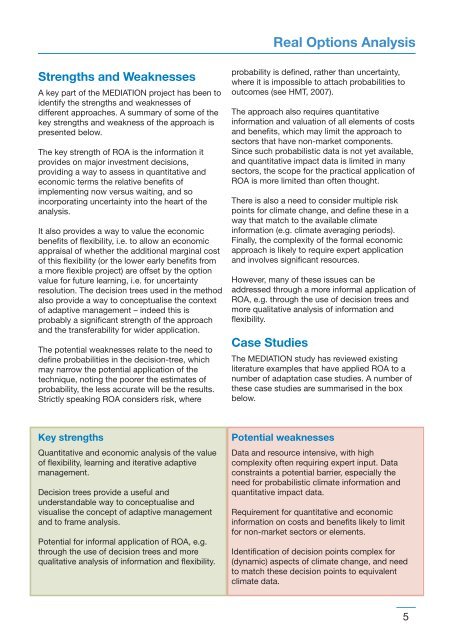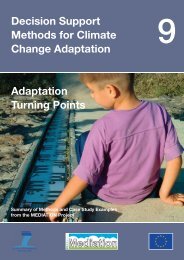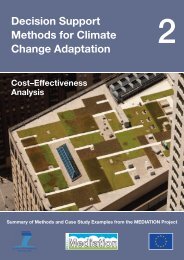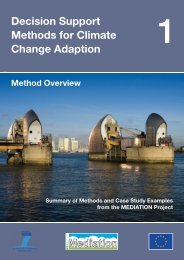Download all Technical Policy Briefing Notes in a single ... - Mediation
Download all Technical Policy Briefing Notes in a single ... - Mediation
Download all Technical Policy Briefing Notes in a single ... - Mediation
- No tags were found...
Create successful ePaper yourself
Turn your PDF publications into a flip-book with our unique Google optimized e-Paper software.
Real Options AnalysisStrengths and WeaknessesA key part of the MEDIATION project has been toidentify the strengths and weaknesses ofdifferent approaches. A summary of some of thekey strengths and weakness of the approach ispresented below.The key strength of ROA is the <strong>in</strong>formation itprovides on major <strong>in</strong>vestment decisions,provid<strong>in</strong>g a way to assess <strong>in</strong> quantitative andeconomic terms the relative benefits ofimplement<strong>in</strong>g now versus wait<strong>in</strong>g, and so<strong>in</strong>corporat<strong>in</strong>g uncerta<strong>in</strong>ty <strong>in</strong>to the heart of theanalysis.It also provides a way to value the economicbenefits of flexibility, i.e. to <strong>all</strong>ow an economicappraisal of whether the additional marg<strong>in</strong>al costof this flexibility (or the lower early benefits froma more flexible project) are offset by the optionvalue for future learn<strong>in</strong>g, i.e. for uncerta<strong>in</strong>tyresolution. The decision trees used <strong>in</strong> the methodalso provide a way to conceptualise the contextof adaptive management – <strong>in</strong>deed this isprobably a significant strength of the approachand the transferability for wider application.The potential weaknesses relate to the need todef<strong>in</strong>e probabilities <strong>in</strong> the decision-tree, whichmay narrow the potential application of thetechnique, not<strong>in</strong>g the poorer the estimates ofprobability, the less accurate will be the results.Strictly speak<strong>in</strong>g ROA considers risk, whereprobability is def<strong>in</strong>ed, rather than uncerta<strong>in</strong>ty,where it is impossible to attach probabilities tooutcomes (see HMT, 2007).The approach also requires quantitative<strong>in</strong>formation and valuation of <strong>all</strong> elements of costsand benefits, which may limit the approach tosectors that have non-market components.S<strong>in</strong>ce such probabilistic data is not yet available,and quantitative impact data is limited <strong>in</strong> manysectors, the scope for the practical application ofROA is more limited than often thought.There is also a need to consider multiple riskpo<strong>in</strong>ts for climate change, and def<strong>in</strong>e these <strong>in</strong> away that match to the available climate<strong>in</strong>formation (e.g. climate averag<strong>in</strong>g periods).F<strong>in</strong><strong>all</strong>y, the complexity of the formal economicapproach is likely to require expert applicationand <strong>in</strong>volves significant resources.However, many of these issues can beaddressed through a more <strong>in</strong>formal application ofROA, e.g. through the use of decision trees andmore qualitative analysis of <strong>in</strong>formation andflexibility.Case StudiesThe MEDIATION study has reviewed exist<strong>in</strong>gliterature examples that have applied ROA to anumber of adaptation case studies. A number ofthese case studies are summarised <strong>in</strong> the boxbelow.Key strengthsQuantitative and economic analysis of the valueof flexibility, learn<strong>in</strong>g and iterative adaptivemanagement.Decision trees provide a useful andunderstandable way to conceptualise andvisualise the concept of adaptive managementand to frame analysis.Potential for <strong>in</strong>formal application of ROA, e.g.through the use of decision trees and morequalitative analysis of <strong>in</strong>formation and flexibility.Potential weaknessesData and resource <strong>in</strong>tensive, with highcomplexity often requir<strong>in</strong>g expert <strong>in</strong>put. Dataconstra<strong>in</strong>ts a potential barrier, especi<strong>all</strong>y theneed for probabilistic climate <strong>in</strong>formation andquantitative impact data.Requirement for quantitative and economic<strong>in</strong>formation on costs and benefits likely to limitfor non-market sectors or elements.Identification of decision po<strong>in</strong>ts complex for(dynamic) aspects of climate change, and needto match these decision po<strong>in</strong>ts to equivalentclimate data.5





